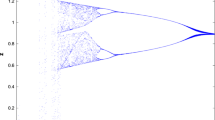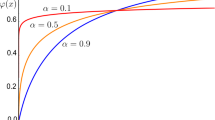Abstract
Atritrophic food-chain chemostat model composed of a prey with Monod-type nutrient uptake, a Holling Type II predator and a Holling Type II exploited superpredator is considered in this paper. The bifurcations of the model show that dynamic complexity first increases and then decreases with the nutrient supplied to the bottom of the food chain. Extensive simulations prove that the same holds for food yield, i.e., there exists an optimum nutrient supply which maximizes mean food yield. Finally, a comparative analysis of the results points out that the optimum nutrient supply practically coincides with the nutrient supply separating chaotic dynamics from high-frequency cyclic dynamics. This reinforces the idea, already known for simpler models, that food yield maximization requires that the system behaves on the edge of chaos.
Similar content being viewed by others
References
Abrams, P. A. (1993). Effect of increased productivity on the abundances of trophic levels. Amer. Nat. 141, 351–371.
Abrams, P. A. and J. D. Roth (1994a). The effects of enrichment of three-species food chains with non-linear functional responses. Ecology 75, 1118–1130.
Abrams, P. A. and J. D. Roth (1994b). The responses of unstable food chains to enrichment. Evol. Ecol. 8, 150–171.
Allen, J. C., W. M. Schaffer and D. Rosko (1993). Chaos reduces species extinction by amplifying local population noise. Nature 364, 229–232.
Bader, F. G., H. M. Tsuchiya and A. G. Fredrickson (1976). Grazing of ciliates on bluegreen algae: effects of ciliate encystment and related phenomena. Biotechnol. Bioeng. 18, 311–332.
Boer, M. P., B. W. Kooi and S.A. Kooijman (1998). Food chain dynamics in the chemostat. Math. Biosci. in press.
Butler, G. J., S. B. Hsu and P. Waltman (1983). Coexistence of competing predators in a chemostat. J. Math. Biol. 17, 133–151.
Canale, R. P. (1969). Predator-prey relationships in a model for the activated process. Biotechnol. Bioeng. 11, 887–907.
Canale, R. P. (1970). An analysis of models describing predator-prey interaction. Biotechnol. Bioeng. 12, 353–378.
Canale, R. P., T. D. Lustig, P. M. Kehrberger and J. E. Salo (1973). Experimental and mathematical modeling studies of protozoan predation on bacteria. Biotechnol. Bioeng. 15, 707–728.
Champneys, A. R. and Yu. A. Kuznetsov (1994). Numerical detection and continuation of codimension-two homoclinic bifurcations. Int. J. Bif. Chaos 4, 785–822.
Cunningham, A. and R. M. Nisbet (1983). Transients and oscillations in continuos culture, in Mathematics in Microbiology, M. Bazin (Ed.), London: Academic Press, pp. 77–103.
De Feo, O. and S. Rinaldi (1997). Yield and dynamics of tritrophic food chains. Amer. Nat. 150, 328–345.
De Feo, O. and S. Rinaldi (1998). Singular homoclinic bifurcations in tri-trophic food chains. Math. Biosci. in press.
Doedel, E. and J. Kernévez (1986). AUTO: software for continuation problems in ordinary differential equations with applications. California Institute of Technology Technical Report, Applied Mathematics, CALTEC, Pasadena.
Drake, J. F. and H. M. Tsuchiya (1976). Predation on Escherichia coli by Colpoda stenii. Appl. Environ. Microbiol. 31, 870–874.
Ferrière, R. and M. Gatto (1993). Chaotic population dynamics can result from natural selection. Proc. Roy. Soc. Lond. B251, 33–38.
Gilpin, M. E. (1972). Enriched predator-prey systems: theoretical stability. Science 177, 902–904.
Gragnani, A. and S. Rinaldi (1995). A universal bifurcation diagram for seasonally perturbed predator-prey models. Bull. Math. Biol. 57, 701–712.
Guckenheimer, J. and P. Holmes (1983). Nonlinear Oscillations, Dynamical Systems and Bifurcations of Vector Fields, New York: Springer.
Hastings, A. and T. Powell (1991). Chaos in a three-species food chain. Ecology 72, 896–903.
Hogeweg, P. and B. Hesper (1978). Interactive instruction on population interaction. Comp. Biol. and Med. 8, 319–327.
Jost, J. L., J. F. Drake, A. G. Fredrickson and H. M. Tsuchiya (1973). Interactions of Tetrahymena pyriformis, Escherichia coli, Azotobacter vinelandii, and glucose in a minimal medium. J. Bacteriol. 113, 834–840.
Kauffman, S. A. (1993). Origin of Order: Self Organization and Selection in Evolution. Oxford: Oxford University Press.
Klebanoff, A. and A. Hastings (1994). Chaos in three-species food chains. J. Math. Biol. 32, 427–451.
Kooi, B. W., M. P. Boer and S. A. Kooijman (1997). Complex dynamic behaviour of autonomous microbial food chains. J. Math. Biol. 36, 24–40.
Kot, M., G. S. Sayler and T. W. Schultz (1992). Complex dynamics in a model microbial system. Bull. Math. Biol. 54, 619–648.
Kuznetsov, Yu. A. (1995). Elements of Applied Bifurcation Theory, New York: Springer.
Kuznetsov, Yu. A., S. Muratori and S. Rinaldi (1992). Bifurcations and chaos in a periodic predator-prey model. Int. J. Bif. Chaos 2, 117–128.
Kuznetsov, Yu. A. and S. Rinaldi (1996). Remarks on food chain dynamics. Math. Biosci. 134, 1–33.
May, R. M. (1972). Limit cycles in predator-prey communities. Science 177, 900–902.
McCann, K. and P. Yodzis (1994). Biological conditions for chaos in a three-species food chain. Ecology 75, 561–564.
McCann, K. and P. Yodzis (1995). Bifurcation structure of three-species food chain model. Theoret. Pop. Biol. 48, 93–125.
Muratori, S. and S. Rinaldi (1992). Low-and high-frequency oscillations in threedimensional food chain systems, SIAM J. Appl. Math. 52, 1688–1706.
Oksanen, L., S. D. Fretwell, J. Arruda and P. Niemela (1981). Exploitation ecosystems in gradients of primary productivity. Amer. Nat. 118, 240–261.
Pavlou, S. and I. G. Kevrekidis (1992). Microbial predation in a periodically operated chemostat: a global study of the interaction between natural and externally imposed frequencies. Math. Biosci. 108, 1–55.
Rapp, P. E., I. D. Zimmerman, A. M. Albano, G. C. de Guzman and N. N. Greenbaum (1985). Dynamics of spontaneous neural activity in the simian motor cortex: the dimension of chaotic neurons. Phys. Lett. 110A, 335–338.
Rinaldi, S., S. Muratori and Yu. A. Kuznetsov (1993). Multiple attractors, catastrophes and chaos in periodically forced predator-prey communities. Bull. Math. Biol. 55, 15–35.
Rosenzweig, M. L. (1971). Paradox of enrichment: destabilization of exploitation ecosystems in ecological time. Science 171, 385–387.
Sarkar, A. K., D. Mitra, S. Ray and A. B. Roy (1991). Permanence and oscillatory co-existence of a detritus-based prey-predator model. Ecol. Model. 53, 147–156.
Scheffer, M. (1991). Should we expect strange attractors behind plankton dynamics and if so, should we bother? J. Plank. Res. 13, 1291–1305.
Smith, H. L. and P. Waltman (1995). The Theory of the Chemostat: Dynamics of Microbial Competition, Cambridge: Cambridge University Press.
Waltman, P. (1983). Competition Models in Population Biology, Philadelphia, PA: Society for Industrial and Applied Mathematics.
West, B. J. and A. L. Goldberger (1987). Physiology in fractal dimensions. Amer. Sci. 75, 354–365.
Author information
Authors and Affiliations
Corresponding author
Rights and permissions
About this article
Cite this article
Gragnani, A., De Feo, O. & Rinaldi, S. Food chains in the chemostat: Relationships between mean yield and complex dynamics. Bull. Math. Biol. 60, 703–719 (1998). https://doi.org/10.1006/bulm.1997.0039
Received:
Accepted:
Issue Date:
DOI: https://doi.org/10.1006/bulm.1997.0039




